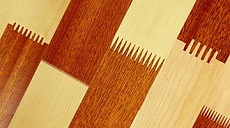
Finger jointed panels have gained popularity in recent years because of their benefits compared to other types of joints such as butt joint or box joint. Finger joints are produced by cutting two complementary, interlocking profiles of small wood panels and then gluing them together for strength. The cutting of the two profiles increases the surface are available for gluing, thus providing strong bond.
Finger jointed panels provide excellent strength and quality at the same time reducing the waste, enabling construction companies to reduce the cost of raw material, which is one of the most important cost items for them. The popularity of finger jointed panels results from the benefits they provide as shown below.
- Higher Strength – Because of the way they are constructed by combining smaller pieces of woods together with a large surface area to glue together, finger jointed panels are much stronger compared to conventional lumber. This provides excellent opportunity to use them in places that require them to bear significant load.
- Better Appearance – Finger jointed panels are more appealing because they reduce or even eliminate unappealing attributes such as wane or discoloration because of the way they are produced.
- Reduced Waste – As mentioned earlier finger jointed panels are produced by combining smaller pieces of woods together. These smaller pieces would have been discarded otherwise since there is not much use of them. Reduction of the waste is not only cost effective, but is also environmentally friendly.
- More Stability – Even very long finger jointed panels provide excellent stability. They reduce warping and twisting considerably because they are produced by combining smaller pieces together.
- More Nailing Surface – Finger joint studs provide better nailing surface since there is less inconsistency along the edge of the surface.
As can be seen finger jointed panels provide significant benefits. As a result they have become popular in large number of applications such as
- Construction beams
- Parquet flooring
- Table tops
- Home staging
- Moulding or trim
- Floor boards
- Doors
If you have not considered them for various uses shown above it’s time to take another look.






